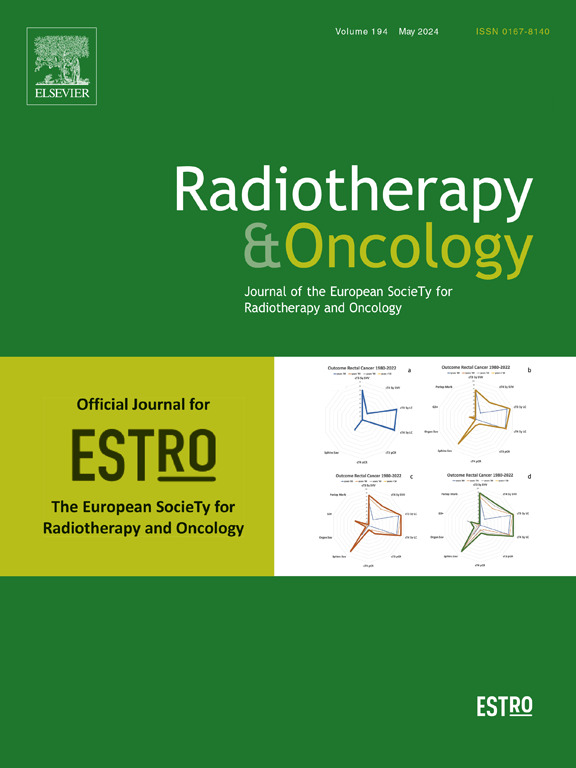小儿型中线结构弥漫性高级别胶质瘤体积增大及适应性放疗的必要性
IF 4.9
1区 医学
Q1 ONCOLOGY
引用次数: 0
摘要
目前儿科型弥漫性高级别胶质瘤放疗方案在总肿瘤体积(GTV)周围应用1.0 cm临床靶体积(CTV)边界。然而,在成人胶质母细胞瘤患者中,在放疗期间观察到GTV的大变化。该研究旨在通过重复磁共振成像绘制6周放疗过程中的GTV变化,并评估计划调整的必要性。同时,评估GTV升高与疾病进展时间(TTP)的关系。材料和方法新诊断的弥漫性中线胶质瘤或弥漫性儿科型中线结构高级别胶质瘤患者接受为期6周的放射治疗,符合入选条件。在预处理阶段(MRI0)和分数10 + 20 (rMRI10/rMRI20)进行MRI扫描。在所有扫描中,GTV都被划定。增加被定义为扫描之间GTV增加 >;5 %。治疗方案的调整需要基于剂量学和视觉标准。与TTP相比,GTV增加了。结果20例患者符合条件。在12/20的患者中,观察到rMR10/rMR20的GTV增加,更具体地说,6/11的脑桥肿瘤和6/9的非脑桥肿瘤。结合剂量学标准和目视检查,14例患者需要20例计划调整。TTP(范围:1.6-17.6 个月)在GTV升高组(中位8.1 个月)和GTV未升高组(中位7.6 个月; = 0.66页)。结论反复显像显示GTV升高60% %,计划适应率70% %。当应用1.0 cm的CTV切缘时,建议调整计划以确保足够的放疗。本文章由计算机程序翻译,如有差异,请以英文原文为准。
Gross tumor volume increase and need for adaptive radiotherapy in pediatric-type diffuse high-grade glioma of the midline structures
Introduction
Current pediatric-type diffuse high-grade glioma radiotherapy protocols apply a 1.0 cm clinical target volume (CTV) margin around the gross tumor volume (GTV). However, in adults with glioblastoma, large variations in GTV are observed during radiotherapy. The study aimed to map the GTV variation during a 6-week course of radiotherapy using repeated MR-imaging and to evaluate the need for plan adaptation. Also, the relation between GTV increase and time to disease progression (TTP) was assessed.
Material and Methods
Patients with newly diagnosed diffuse midline glioma or diffuse pediatric-type high-grade glioma of the midline structures undergoing a 6-week radiotherapy course, were eligible for inclusion. MRI scans were performed in the pre-treatment phase (MRI0), and at fraction 10 + 20 (rMRI10/rMRI20). On all scans, GTV was delineated. An increase was defined as a >5 % increase of GTV between scans. The need for treatment plan adaptation was based on dosimetric and visual criteria. GTV increase was compared to TTP.
Results
Twenty patients were eligible. In 12/20 patients, a GTV increase was observed at rMR10/rMR20, more specifically in 6/11 pontine and 6/9 non-pontine tumors. Combining dosimetric criteria and visual inspection, 20 plan adaptations in 14 patients were required. The TTP (range: 1.6–17.6 months) was not significantly different between the group with (median 8.1 months) versus without a GTV increase (median 7.6 months; p = 0.66).
Conclusion
Repeated imaging demonstrated a GTV increase in 60 % of patients and plan adaptation in 70 %. When applying CTV margins of 1.0 cm, plan adaptation is recommended to ensure adequate radiotherapy treatment.
求助全文
通过发布文献求助,成功后即可免费获取论文全文。
去求助
来源期刊

Radiotherapy and Oncology
医学-核医学
CiteScore
10.30
自引率
10.50%
发文量
2445
审稿时长
45 days
期刊介绍:
Radiotherapy and Oncology publishes papers describing original research as well as review articles. It covers areas of interest relating to radiation oncology. This includes: clinical radiotherapy, combined modality treatment, translational studies, epidemiological outcomes, imaging, dosimetry, and radiation therapy planning, experimental work in radiobiology, chemobiology, hyperthermia and tumour biology, as well as data science in radiation oncology and physics aspects relevant to oncology.Papers on more general aspects of interest to the radiation oncologist including chemotherapy, surgery and immunology are also published.
 求助内容:
求助内容: 应助结果提醒方式:
应助结果提醒方式:


